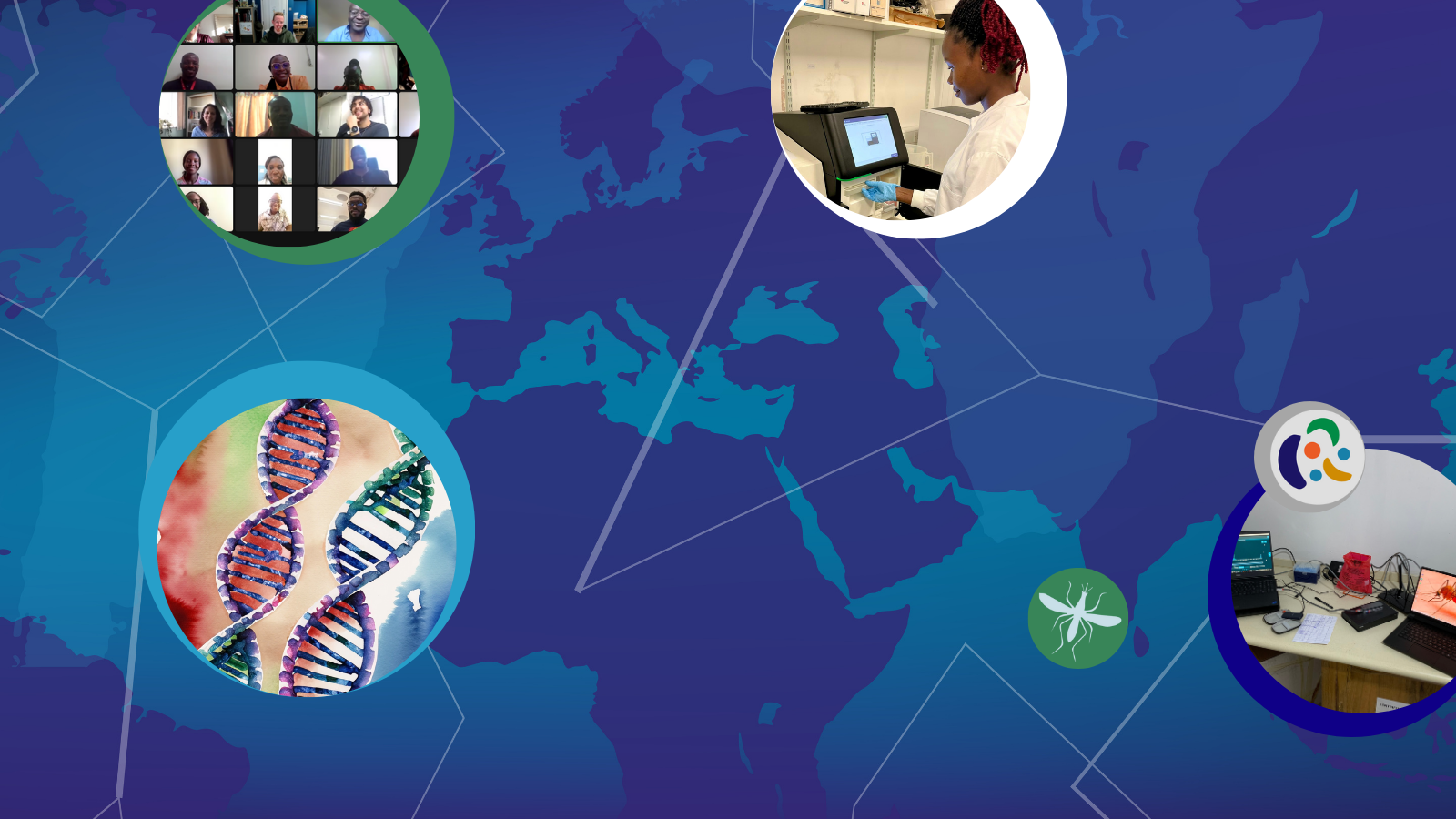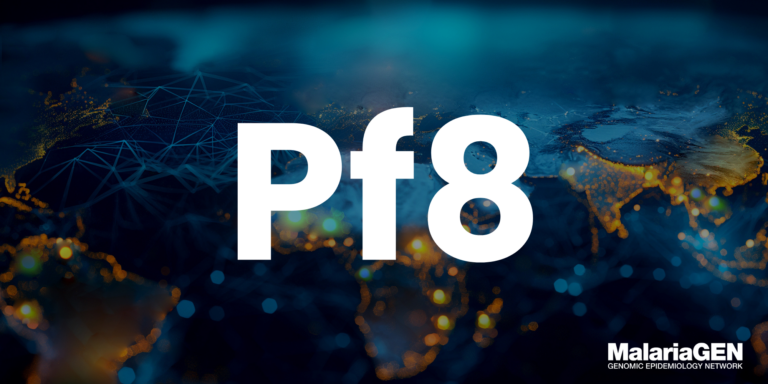As we mark World Malaria Day this year, there is no doubt that the fight against malaria has come a long way. Several new tools to curb malaria-carrying mosquitoes and the parasites they carry are being deployed or are in development, and malaria vaccines promise to turn the tide against rising malaria cases among vulnerable populations.
Two malaria genomics researchers from the MalariaGEN community, Honorine Kaboré and Dr Fiacre Agossa, demonstrate that malaria genomics research and surveillance remain important in accelerating the fight against malaria. Through their work, they are generating crucial information and building capacity to enable more people to utilise genomics to guide malaria elimination efforts.
Honorine Kaboré
“We all benefit from good collaboration between institutions and between countries. By working together, we can find solutions and take action against malaria together.”

Last year, Honorine Kaboré completed the training course in data analysis for genomic surveillance of African malaria vectors, run jointly by MalariaGEN and the Pan-African Mosquito Control Organisation (PAMCA). She is part of a growing community of budding malaria scientists tapping into vector genomic resources to gain important insights to aid malaria control.
“I analysed Anopheles funestus genomic data from all over the African region to understand its population structure,” she explains, referring to the project she undertook as part of the training course. “It was very useful and helped me to orient my research.”
This is important because one of the focuses of Honorine’s PhD research is on the population genomics of the An. gambiae complex and An. funestus mosquitoes. By comparing large numbers of mosquito genome sequences, patterns within and among populations can be identified. This helps her piece together the evolutionary dynamics of mosquitoes, how genes are transferred between them, and any genetic variations present.
Honorine is usually based at the Institut de Recherche en Sciences de la Santé (IRSS) in Burkina Faso. However, her research has currently led her to the Liverpool School of Tropical Medicine in the UK.
Here, she is mastering the MiSeq sequencing system, a compact and relatively affordable tool for end-to-end amplicon sequencing of genomes. It handles tasks like DNA amplification, genomic sequencing, and analysis through a streamlined process. Within the remit of Honorine’s PhD project, this training will build capacity for genomic sequencing and surveillance to be carried out in Burkina Faso.

“MiSeq is very important for the lab because you don't have to do whole genome sequencing to [learn about] specific regions of the mosquito genome. You can run MiSeq to evaluate insecticide resistance in the field, or the genetic variation in some target genes.”
Given the intriguing connection of Honorine's research to gene drive methodologies, monitoring target genes is crucial. Organisations like Target Malaria are pioneering the use of this cutting-edge vector control technology to reduce the population of malaria-carrying mosquitoes.
But before gene drive mosquitoes can be deployed in Burkina Faso, researchers like Honorine are determined to use genomic surveillance to help ensure that they will be safe and effective. Her project is part of a wider piece of work led by Professor Abdoulaye Diabate, and they are building a strong evidence base to facilitate the implementation of this tool.
“By studying gene flow and population structure, we want to find out: how might the target genes for gene drive spread within mosquito populations? What genetic variations exist, and how do they influence the transmission of malaria?” She says that the answers to these questions hold the key to more effective malaria control strategies.
Honorine believes that the utility of genomics for malaria control cannot be understated, whether in identifying target genes for modification or assessing the effectiveness of current vector control tools.
“With genomics, we can find out the genetic diversity and population structure of mosquitoes, and this can help us know how new genetics-based control tools will work in the field.”
The rise in insecticide resistance threatens to diminish the efficacy of the malaria vector control measures currently approved for use. “Mosquitoes can adapt by developing resistance to insecticides, so it can limit the existing tools,” says Honorine. “We need to track how mosquitoes behave and evolve. Genomics is at the centre of all those control tools.”
Honorine's understanding of malaria extends beyond her PhD and lab work. Her interactions with the communities affected by malaria in Burkina Faso during her ventures into the field to collect mosquito samples are a reminder that behind every data point lies a human story.
“They will ask you - ah, you want to collect the mosquitoes? That’s good because malaria disturbs us a lot. You have to work on that and eliminate malaria soon, then we can be in peace.”
Honorine plans to go full steam ahead with the next phase of her training at the Wellcome Sanger Institute, where she will build on her vector data analysis training and learn some exciting new lab skills. “I will continue the analysis of whole genome sequence data from samples we shipped from Burkina Faso [available through MalariaGEN], and learn to use the ANOSPP panel for mosquito species identification.”
Her ultimate goal is to take this knowledge back to her lab in IRSS and empower more scientists like her to lead malaria control efforts.
“We all benefit from good collaboration between institutions and between countries. By working together, we can find solutions and take action against malaria together.”
Dr Fiacre Agossa
“We are at a crossroads for malaria elimination. What we are learning from the genomes of mosquitoes and parasites will help with the development of new tools and improve existing ones.”

The Democratic Republic of Congo (DRC) is the largest country in sub-Saharan Africa in terms of land area. It also has the second-highest malaria burden within the African continent.
“One province here is nearly equal to or bigger than a country like Togo or Benin. So there is a lot of information that we don't have,” says Dr Fiacre Agossa, a public health entomologist supporting vector monitoring and control activities of the DRC’s National Malaria Control Program (NMCP), and local research institutions such as the Institut National de Recherche Biomédicale (INRB) and the Kinshasa School of Public health (KSPH). For over a decade, he has been deeply engaged in researching malaria vectors, collaborating on various projects with the US President’s Malaria Initiative (PMI) and stakeholders.
As it stands, there are currently twenty-six sentinel surveillance sites across the DRC where data on malaria is collected – one site per province. “We were collecting information from just one single point in the province.” This is only a fraction of what is needed for thorough surveillance.
“We also only have information about the major malaria vectors. We don't have complete and up-to-date information on the composition of all the species present.”
In partnership with the University of North Carolina’s ongoing DRC PaluSeq (séquençage du paludisme) Programme, the DRC NMCP and MalariaGEN, Dr Agossa and his team are setting up a comprehensive new project to conduct country-wide genomic surveillance for both malaria parasites and vectors in an integrated way.
“With the [DRC Paluseq] programme, we have already been sequencing malaria parasites to study the evolution of drug resistance and transmission of malaria,” he explains. Since efforts to establish and coordinate molecular surveillance on malaria parasites are already underway, Dr Agossa is confident that they can expand on these existing activities to include surveillance for vectors.
“The equipment and machines for sequencing are now in place, so what is remaining is to train people on the vector side and we will also be able to sequence and analyse mosquitoes in the country.”
In the long term, the sustainability of capacity building is a priority for this initiative, and Dr Agossa emphasises that decentralisation of entomology and genomics expertise across the country is key to this.
“Right now, all specialists are based at the central level in Kinshasa, so the provinces don't have enough people to lead entomological surveillance. And it's expensive to send people from the central level to the provinces.”
Through initiatives like community-based mosquito collection and PhD opportunities in affiliation with universities in each region, Dr Agossa explains that the ultimate goal is to empower communities.
“We want each province to be able to provide evidence for decision-making, so we’re focusing on capacity building and localisation of medical entomology and genomics expertise. That’s why we want to train the next generation of researchers to conduct molecular surveillance at the local level."
If funding is approved, the plan also includes increasing the number of surveillance sites per province. Dr Agossa explains, "We aim to collect data from multiple sites (at least four) within each province to see mosquito population genetic structure per province. It's still not enough but it’s a good starting point.”
This comes at a time of change in the vector control landscape in the DRC, which has recently started to deploy the new generation of WHO-recommended Insecticide Treated Nets (ITNs).

“If the mosquitoes have evolved to have resistance towards insecticides used in the ITNs, we need to learn more about the mechanism being developed by mosquitoes to adapt. We want to know if these changes are impacting vector composition and behaviours.”
With malaria patterns evolving in DRC and around the world in response to climate change and new control measures, understanding the genetic makeup of both parasites and vectors becomes paramount.
“We are at a crossroads for malaria elimination. Unfortunately, the numbers are not in our favour,” says Dr Agossa, referring to the mounting threats to malaria control in sub-Saharan Africa.
“We are asking many questions based on genomic research evidence. What we are learning from the genomes of mosquitoes and parasites will help with the development of new tools and improve existing ones.”


